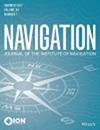基于地球GPS时传的月球卫星导航系统设计实例分析
IF 2
3区 地球科学
Q1 ENGINEERING, AEROSPACE
引用次数: 0
摘要
利用小卫星平台设计未来月球导航卫星系统(LNSS)的兴趣越来越大。然而,许多设计决策,例如,关于卫星时钟和月球轨道,尚未最终确定。在我们之前的工作中,我们开发了一种LNSS架构,该架构利用间歇性可用的地球gps信号来计算时间校正,从而减少了对更高级别机载时钟的需求。在这项工作中,我们制定了20个不同等级时钟和月球轨道的案例研究,以分析设计具有地球GPS时间传输的基于小卫星的LNSS时的权衡。对于每个案例研究,测距信号的精度通过月球用户等效距离误差(UERE)进行评估。即使使用较低级的时钟,月球UERE的性能也可与地球GPS相媲美。此外,当可用的地球- gps测量以不同的速率处理时,还研究了月球UERE的变化。本文章由计算机程序翻译,如有差异,请以英文原文为准。
A Case Study Analysis for Designing a Lunar Navigation Satellite System with Time Transfer from the Earth GPS
There is growing interest in designing a future lunar navigation satellite sys - tem (LNSS) while utilizing a SmallSat platform. However, many design deci - sions, e.g., regarding the satellite clock and lunar orbit, are yet to be finalized. In our prior work, we developed an LNSS architecture that leverages intermit - tently available Earth-GPS signals to compute timing corrections, thereby alle - viating the need for a higher-grade onboard clock. In this work, we formulate twenty case studies with different grades of clocks and lunar orbits to analyze the trade-offs in designing a SmallSat-based LNSS with time transfer from the Earth GPS. For each case study, the accuracy of ranging signals is assessed via the lunar user equivalent range error (UERE). Even with lower-grade clocks, the lunar UERE exhibits performance comparable to that of the Earth GPS. Furthermore, variations in the lunar UERE are also examined when the avail - able Earth-GPS measurements are processed at different rates.
求助全文
通过发布文献求助,成功后即可免费获取论文全文。
去求助
来源期刊

Navigation-Journal of the Institute of Navigation
ENGINEERING, AEROSPACE-REMOTE SENSING
CiteScore
5.60
自引率
13.60%
发文量
31
期刊介绍:
NAVIGATION is a quarterly journal published by The Institute of Navigation. The journal publishes original, peer-reviewed articles on all areas related to the science, engineering and art of Positioning, Navigation and Timing (PNT) covering land (including indoor use), sea, air and space applications. PNT technologies of interest encompass navigation satellite systems (both global and regional), inertial navigation, electro-optical systems including LiDAR and imaging sensors, and radio-frequency ranging and timing systems, including those using signals of opportunity from communication systems and other non-traditional PNT sources. Articles about PNT algorithms and methods, such as for error characterization and mitigation, integrity analysis, PNT signal processing and multi-sensor integration, are welcome. The journal also accepts articles on non-traditional applications of PNT systems, including remote sensing of the Earth’s surface or atmosphere, as well as selected historical and survey articles.
 求助内容:
求助内容: 应助结果提醒方式:
应助结果提醒方式:


